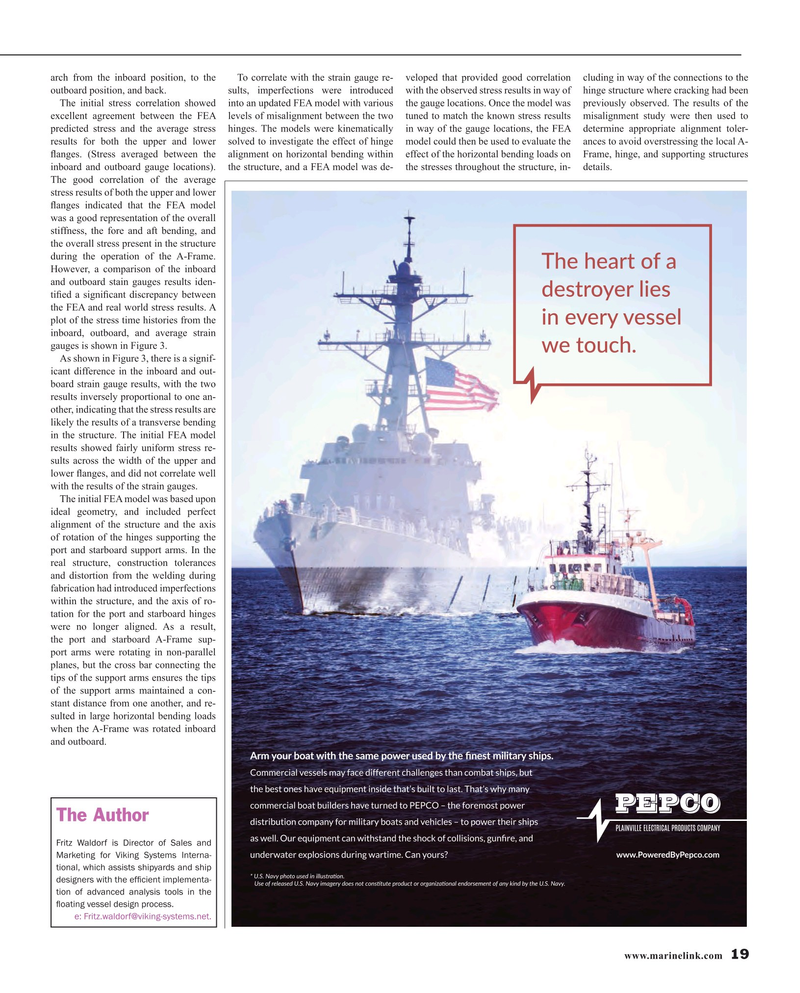
Page 19: of Maritime Reporter Magazine (March 2016)
Green Marine Technology
Read this page in Pdf, Flash or Html5 edition of March 2016 Maritime Reporter Magazine
arch from the inboard position, to the To correlate with the strain gauge re- veloped that provided good correlation cluding in way of the connections to the outboard position, and back. sults, imperfections were introduced with the observed stress results in way of hinge structure where cracking had been
The initial stress correlation showed into an updated FEA model with various the gauge locations. Once the model was previously observed. The results of the excellent agreement between the FEA levels of misalignment between the two tuned to match the known stress results misalignment study were then used to predicted stress and the average stress hinges. The models were kinematically in way of the gauge locations, the FEA determine appropriate alignment toler- results for both the upper and lower solved to investigate the effect of hinge model could then be used to evaluate the ances to avoid overstressing the local A- ? anges. (Stress averaged between the alignment on horizontal bending within effect of the horizontal bending loads on Frame, hinge, and supporting structures inboard and outboard gauge locations). the structure, and a FEA model was de- the stresses throughout the structure, in- details.
The good correlation of the average stress results of both the upper and lower ? anges indicated that the FEA model was a good representation of the overall stiffness, the fore and aft bending, and the overall stress present in the structure during the operation of the A-Frame.
The heart of a
However, a comparison of the inboard and outboard stain gauges results iden- destroyer lies ti? ed a signi? cant discrepancy between the FEA and real world stress results. A plot of the stress time histories from the in every vessel inboard, outboard, and average strain gauges is shown in Figure 3.
we touch.
As shown in Figure 3, there is a signif- icant difference in the inboard and out- board strain gauge results, with the two results inversely proportional to one an- other, indicating that the stress results are likely the results of a transverse bending in the structure. The initial FEA model results showed fairly uniform stress re- sults across the width of the upper and lower ? anges, and did not correlate well with the results of the strain gauges.
The initial FEA model was based upon ideal geometry, and included perfect alignment of the structure and the axis of rotation of the hinges supporting the port and starboard support arms. In the real structure, construction tolerances and distortion from the welding during fabrication had introduced imperfections within the structure, and the axis of ro- tation for the port and starboard hinges were no longer aligned. As a result, the port and starboard A-Frame sup- port arms were rotating in non-parallel planes, but the cross bar connecting the tips of the support arms ensures the tips of the support arms maintained a con- stant distance from one another, and re- sulted in large horizontal bending loads when the A-Frame was rotated inboard and outboard. ul?o?u0o-|?b|_|_;v-l;ro?;u?v;70?|_;Cm;v|lb?b|-u?v_brvl
Commercial vessels may face different challenges than combat ships, but the best ones have equipment inside that’s built to last. That’s why many commercial boat builders have turned to PEPCO – the foremost power
The Author distribution company for military boats and vehicles – to power their ships
PLAINVILLE ELECTRICAL PRODUCTS COMPANY
EW[IPP3YVIUYMTQIRXGER[MXLWXERHXLIWLSGOSJGSPPMWMSRWKYRcVIERH
Fritz Waldorf is Director of Sales and ???lo?;u;7?;r1ol1ol underwater explosions during wartime. Can yours?
Marketing for Viking Systems Interna- tional, which assists shipyards and ship
R&?"?-??r_o|o?v;7bmb???v|u-?om? designers with the ef? cient implementa- &v;o=u;?;-v;7&?"?-??bl-];u?7o;vmo|1omv?|?|;ruo7?1|ouou]-mb?-?om-?;m7ouv;l;m|o=-m?hbm70?|_;&?"?-???
tion of advanced analysis tools in the ? oating vessel design process. e: [email protected]. www.marinelink.com 19
MR #3 (18-25).indd 19 3/2/2016 9:50:18 AM

 18
18

 20
20
